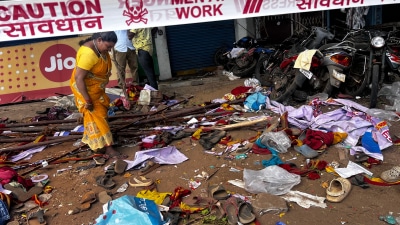Close to the bone
THE incessant chatter in the orthopaedic female ward at the Government General Hospital (GGH) in Chennai is deceptive. It barely stifles Ham...

THE incessant chatter in the orthopaedic female ward at the Government General Hospital (GGH) in Chennai is deceptive. It barely stifles Hamsaveni’s misery. She had just been told that cancer had spread to the brains of her scrawny daughter, Uma Devi. The child had been brought to the hospital from Coimbatore after she was diagnosed with osteosarcoma—the commonest bone cancer and the sixth most common cancer among children —in her right leg.
A limb salvage surgery was conducted on the pretty 11-year-old in early June, when the cancerous tumour along with the bone was removed and replaced with gifted bone tissues. The delay in the surgery, however, dramatically shortened Uma’s life to a mere six months from a possible five years as the cancer got the window to spread to her brains.
For the first exclusive and dedicated bone bank in a government institution in the country, she became another unnecessary statistic.
FOR the 170-year-old hospital with many firsts to its credit, the bone bank is a ‘‘significant leap’’ in healthcare. But while the state government has allotted around Rs 75 lakh for the bank, it will be another 5-10 years before donors stack the freezer shelves with femurs (thigh bones) and tibias (leg bones).
Until then, the two deep freezers on the sixth floor of the massive new twin blocks will depend on donors in Sri Lanka. Apart from bones, the freezers also stock ‘bone heads’ and chips of worn bones, sliced off during surgeries. All are essential for reconstructive surgeries, mostly for victims of osteosarcoma (which accounts for one per cent of all types of cancers) or accidents.
‘‘Cadaveric bone will be procured, processed and preserved according to international standards in this bank,’’ explained Dr Mahil Vahanan Natarajan, eminent orthopaedic surgeon and professor and head of the department of orthopaedic surgery in the hospital. ‘‘Orthopaedics all over the country can source bones from our bank for reconstruction of skeletal defects after trauma and tumour-excision in their patients.’’
Until the 1980s, the hospital followed the amputation route for osteosarcoma patients. Then it began manufacturing its own prosthesis using steel or titanium. ‘‘We sliced off the diseased portion of the bone and replace it with metallic implants. Today, we can replace the diseased bone with a healthy bone,’’ says Dr Natarajan.
As crucially, the cost of limb salvage operations comes down from Rs 40,000 to Rs 5,000. Infection risks will also be cut drastically.
RIGHT now, though, the focus is on creating awareness for bone donations. While popular actor Kamal Hasan’s recent announcement that he would donate his entire body to the Directorate of Medical Education created quite a stir, donation of bones—unlike blood, eyes, kidney and other organs—is yet to catch on.
But Dr Natarajan is optimistic. ‘‘Even two years ago, a woman came to me with her 18-year-old daughter, who was suffering from osteosarcoma. She will willing to sacrifice one of her legs for her daughter and even petitioned the chief minister’s cell for permission. But her relatives intervened, demanding to know the success rate of limb transplants, and the whole effort fell through,’’ he says.
In the past two years, since allograft—transplants of large organs or tissues—gained popularity, the GGH has conducted 20 limb salvage operations using donor bones. All used bones imported from Sri Lanka at a cost of $150-200, plus 40 per cent duty, on patients who could afford to pay for the surgery.
Since the inauguration of the bank, Dr Natarajan says he has received a lot of calls from old patients who want to donate their bones. But the bank is yet to put in place a system to process the offers. Bones can be sourced from live donors, who lose their limbs due to accidents, or from cadavers or from the brain dead, who need to be free of diseases like Hepatitis-B, HIV and cancer and in the 15-55 age group.
The donated bones go through a recommended protocol wherein all the tissues (fat globulous marrow) are removed by a mechanical process. The bones are then stored in deep freezers at -80 degree C. The bones thus harvested can be stored up to five years.
For Uma Devi, though, this is poor consolation. She had to wait for nearly four months for her reconstructive surgery, just because a vascular surgeon was not available. And why not? ‘‘Orthopaedic and vascular surgeons have the same operation days, we couldn’t coordinate schedules,’’ says a doctor unwilling to be named.







- 01
- 02
- 03
- 04
- 05
























